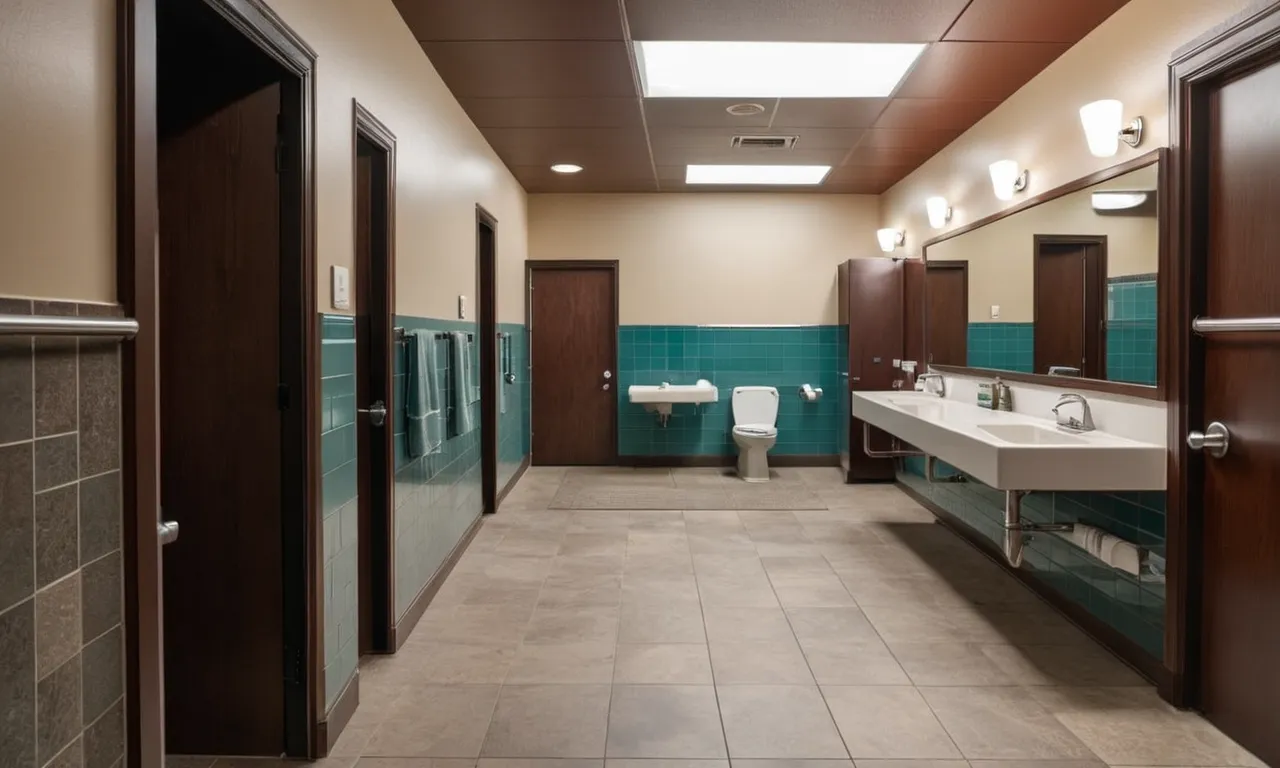Comprehensive Guide To Ada Room Requirements
Ensuring accessibility for individuals with disabilities is not just a legal obligation, but a moral imperative that promotes inclusivity and equal opportunities for all. When it comes to designing and constructing buildings, adhering to the Americans with Disabilities Act (ADA) room requirements is crucial for creating an environment that is welcoming and accommodating for everyone.
If you’re short on time, here’s a quick answer to your question: The ADA room requirements cover various aspects of accessible design, including clearance spaces, turning spaces, door widths, hardware heights, and amenities like grab bars and accessible routes.
These guidelines aim to ensure that individuals with disabilities can navigate and utilize spaces comfortably and independently.
In this comprehensive guide, we will delve into the intricacies of ADA room requirements, exploring the specific regulations, measurements, and best practices that architects, designers, and builders should adhere to.
From bathrooms and bedrooms to living areas and kitchens, we’ll cover the essential elements that contribute to an inclusive and accessible environment.
Understanding the ADA Room Requirements
Overview of the Americans with Disabilities Act (ADA)
The Americans with Disabilities Act (ADA) is a groundbreaking civil rights law that prohibits discrimination against individuals with disabilities in all areas of public life, including employment, transportation, public accommodations, and more.
Enacted in 1990, the ADA aims to ensure equal opportunities and accessibility for people with disabilities, promoting their full participation in society. https://www.ada.gov/ is the official website for ADA information and resources.
Importance of Accessible Design
Accessible design is a crucial aspect of creating an inclusive environment for everyone, regardless of their physical or cognitive abilities. By adhering to ADA room requirements, businesses and public spaces can ensure that individuals with disabilities have equal access and can navigate the premises with ease and dignity.
This not only promotes social inclusion but also demonstrates a commitment to human rights and ethical business practices. According to the Centers for Disease Control and Prevention (CDC), 1 in 4 adults in the United States lives with a disability, highlighting the significant need for accessible design.
Scope of ADA Room Requirements
The ADA room requirements cover a wide range of aspects, including:
- Accessible entrances and doorways
- Clear floor space and maneuvering room
- Accessible bathroom facilities
- Appropriate lighting and signage
- Assistive technology and communication aids
These requirements aim to ensure that individuals with disabilities can comfortably and safely access and utilize various spaces, such as hotel rooms, offices, classrooms, and public restrooms. By following these guidelines, businesses and organizations can create an inclusive environment that empowers individuals with disabilities and promotes equal opportunities.
Compliance with ADA room requirements is not only a legal obligation but also a testament to a company’s commitment to diversity, equity, and inclusiveness.
Understanding and adhering to the ADA room requirements is crucial for creating an accessible and inclusive environment for all. By embracing these guidelines, businesses and organizations can demonstrate their commitment to diversity, equity, and inclusiveness, while also promoting the full participation and empowerment of individuals with disabilities.
Don’t miss out on this opportunity to make a positive impact and create a truly inclusive society! 🎉
Bathroom and Toilet Room Requirements
When designing accessible bathrooms and toilet rooms, it’s crucial to adhere to the ADA Standards for Accessible Design. These guidelines ensure that individuals with disabilities can comfortably and safely use these facilities. Let’s delve into the key requirements:
Clearance Spaces and Turning Radiuses
Accessible bathrooms and toilet rooms must provide ample clearance spaces and turning radiuses to accommodate wheelchairs and other mobility aids. According to the U.S. Access Board, a minimum clear floor space of 60 inches (152.4 cm) in diameter or a T-shaped space is required for a wheelchair to make a 180-degree turn.
Additionally, toilet stalls should have a minimum depth of 59 inches (149.9 cm) and width of 60 inches (152.4 cm) for wall-hung toilets and 59 inches (149.9 cm) for floor-mounted toilets. These dimensions ensure that individuals with disabilities can easily maneuver and transfer onto the toilet.
Accessible Toilet Stalls and Grab Bars
Accessible toilet stalls must be equipped with grab bars to assist individuals with disabilities in transferring on and off the toilet. The ADA guidelines mandate the installation of grab bars on the rear and side walls, positioned at specific heights and lengths to provide optimal support. For instance, rear grab bars should be 36 inches (91.4 cm) long, while side grab bars should be at least 42 inches (106.7 cm) long.
These grab bars must be securely mounted and able to withstand a minimum of 250 pounds (113.4 kg) of force.
Sink and Countertop Heights
To ensure accessibility, sinks and countertops in bathrooms must be designed at appropriate heights. According to the ADA Standards, the maximum height for a sink rim should be 34 inches (86.4 cm) above the finished floor.
As for countertops, they should be no higher than 34 inches (86.4 cm) above the finished floor. This allows individuals using wheelchairs or other mobility aids to comfortably approach and use these fixtures.
Additionally, knee and toe clearances beneath sinks and countertops are essential to provide adequate space for wheelchair users.
Shower and Bathtub Accessibility
Showers and bathtubs in accessible bathrooms must meet specific requirements to ensure safety and usability for individuals with disabilities. The ADA Standards recommend shower stalls to be at least 36 inches (91.4 cm) wide by 36 inches (91.4 cm) deep, with a maximum threshold height of 0.5 inches (1.3 cm). Grab bars should be installed on the walls surrounding the shower area, and a folding or non-folding seat is often required.
For bathtubs, a clear floor space of 30 inches (76.2 cm) by 60 inches (152.4 cm) should be provided for parallel approach, and grab bars must be installed on the control end and foot end of the tub. These features enhance safety and independence for individuals with disabilities while bathing or showering.
By adhering to these ADA bathroom and toilet room requirements, businesses and public facilities can ensure accessibility and inclusivity for all individuals, regardless of their abilities. Compliance not only promotes equal opportunities but also fosters a more welcoming and inclusive environment for everyone.
😊
Bedroom and Living Area Requirements
Ensuring accessibility in bedrooms and living areas is crucial for individuals with disabilities. The Americans with Disabilities Act (ADA) provides comprehensive guidelines to ensure these spaces are designed with inclusivity in mind. Let’s dive into the key requirements:
Maneuvering Clearances and Turning Spaces
Adequate maneuvering clearances and turning spaces are essential for wheelchair users and those with mobility aids. The ADA recommends a minimum clear floor space of 30 inches by 48 inches for wheelchairs to turn and maneuver.
Additionally, a 60-inch diameter turning circle should be provided in bedrooms and living areas to allow for easy navigation. These clearances ensure individuals can move freely without obstruction. https://www.access-board.gov/ada/
Door Widths and Hardware Heights
Doors are a critical component of accessibility. The ADA mandates that all doors leading to bedrooms and living areas have a minimum clear width of 32 inches to accommodate wheelchairs and mobility aids.
Furthermore, door hardware, such as handles and locks, should be installed at a maximum height of 48 inches from the floor, ensuring they are within reach for individuals in wheelchairs or those with limited mobility. 😊 https://www.ada.gov/regs2010/2010ADAStandards/2010ADAstandards.htm
Accessible Routes and Pathways
Creating accessible routes and pathways within bedrooms and living areas is crucial. The ADA requires a minimum clear width of 36 inches for pathways, allowing for comfortable passage of wheelchairs and mobility aids.
Additionally, any changes in floor levels must be addressed with ramps or lifts, ensuring seamless navigation for individuals with disabilities. These requirements ensure that everyone can move freely and independently within these spaces. 👍
Furniture Placement and Clearances
The placement of furniture can significantly impact accessibility. The ADA guidelines recommend leaving at least 36 inches of clearance between furniture pieces to accommodate wheelchairs and mobility aids.
Additionally, furniture should be arranged in a manner that provides clear pathways and turning spaces. It’s also advisable to choose furniture with adjustable heights or removable components to accommodate various needs.
By following these guidelines, individuals with disabilities can comfortably navigate and utilize the living and bedroom areas without barriers.
Implementing these ADA requirements in bedrooms and living areas is not only a legal obligation but also a testament to inclusivity and equality. By creating accessible spaces, we foster a more inclusive society where everyone can feel welcome and empowered to live independently.
Remember, small adjustments can make a significant difference in someone’s life. 🎉
Kitchen and Dining Area Requirements
Ensuring accessibility in the kitchen and dining area is crucial for individuals with disabilities to navigate and use these spaces comfortably. The Americans with Disabilities Act (ADA) provides guidelines to ensure inclusive design, promoting independence and equal opportunities for all.
Let’s dive into the key requirements for these areas:
Countertop Heights and Knee Clearances
According to the ADA Standards for Accessible Design, countertops should be positioned at a maximum height of 34 inches from the floor, with a knee clearance of at least 27 inches high, 30 inches wide, and 19 inches deep.
This allows individuals using wheelchairs or other mobility devices to comfortably access and use the countertops. 😊
Accessible Appliances and Controls
Appliances and controls should be designed with accessibility in mind. Oven controls and handles should be within reach, typically between 15 and 48 inches from the floor. Refrigerators with side-by-side doors or bottom freezers are preferred, as they provide easier access.
Dishwashers should have raised or lowered tops to accommodate wheelchair users. Additionally, appliances with front-mounted controls and easy-to-read displays can greatly enhance usability. 👍
Clearances for Maneuvering and Turning
Adequate clearances are essential for individuals using mobility devices to navigate the kitchen area. The ADA recommends a minimum of 60 inches of clearance between opposing counters or appliances. Additionally, a 60-inch turning radius should be provided in U-shaped kitchens to allow for comfortable maneuvering.
These clearances not only facilitate movement but also promote safety and independence.
- According to a study by the National Kitchen and Bath Association, over 75% of homeowners prioritize accessibility features when renovating their kitchens.
- The U.S. Census Bureau reports that approximately 1 in 4 adults in the United States has a disability, highlighting the importance of accessible design.
Accessible Dining Areas and Tables
Dining spaces should be designed to accommodate individuals with disabilities, ensuring they can comfortably participate in meals and social gatherings. The ADA recommends a minimum of 36 inches of clearance around dining tables to allow for wheelchair access.
Tables with removable or extendable legs can provide additional knee clearance when needed. Choosing tables with rounded edges can also enhance safety and prevent potential injuries.
By adhering to these ADA guidelines, you can create an inclusive and accessible environment in your kitchen and dining area, promoting independence and equal opportunities for all. Don’t hesitate to consult with accessibility experts or refer to authoritative resources like the U.S.
Access Board
for further guidance and updates on accessibility standards. Remember, an accessible design not only benefits individuals with disabilities but also enhances the overall user experience for everyone. 🎉Conclusion
Adhering to the ADA room requirements is not just a legal obligation, but a commitment to creating an inclusive and accessible environment for all individuals, regardless of their abilities. By understanding and implementing these guidelines, architects, designers, and builders can ensure that every space is designed with accessibility in mind, promoting independence, dignity, and equal opportunities for people with disabilities.
Remember, accessibility is not just about meeting minimum standards; it’s about embracing a mindset of inclusivity and creating spaces that truly cater to the diverse needs of all individuals. By prioritizing ADA room requirements, we can build a more inclusive society where everyone feels welcomed, valued, and empowered to live their lives to the fullest.








